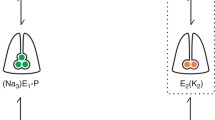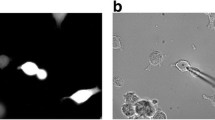Abstract
We have investigated the possible existence of a Na+/H+ ion exchanger in the frog skin epithelium by using isotopic methods and two amiloride analogues: 5-(N-ethyl-N-isopropyl)-amiloride (EIPA) and phenamil. We found phenamil to be a specific blocker of sodium entry to its cellular transport compartment since it inhibited both the transepithelial Na+ influxes (J 13) with aK I of 4·10−7 mol/l and the Na+ pool (control: 77±4 neq·h−1·cm−2; phenamil: 21±1 neq·h−1·cm−2). On the contrary EIPA (10−5 mol/l) had no effect onJ 13 nor on the apical Na+ conductance. Acidification of the epithelium by passing from a normal Ringer (25 mmol/l HCO −3 , 5% CO2, pH 7.34) to a HCO −3 -free Ringer (5% CO2, pH 6.20) while blocking the Na+ conductance with phenamil, produced a large stimulation of Na+ influxes exclusively across the basolateral membranes (J 32), after return to a normal Ringer (J 32=706±76 and 1635±199 neq·h−1·cm−2 in control and acid-loaded epithelia respectively). The stimulation ofJ 32 was initiated when the epithelia were acid-loaded with Ringer of pH lower than 6.90 and was blocked by amiloride (K I=7·10−6 mol/l) and EIPA (K I=5·10−7 mol/l) whereas phenamil had no effect. In na+-loaded epithelia (ouabain treated) the Na+ efflux across the basolateral membranes was stimulated by an inwardly directed proton gradient and was blocked by EIPA (10−5 mol/l) or amiloride (10−4 mol/l), a result suggesting reversibility of the mechanism. We conclude that a Na+ permeability mediated by a Na+/H+ ion exchanger exists in the basolateral membranes, which is stimulated by intracellular acidification and is sensitive to amiloride or EIPA. This exchanger is proposed to be involved in intracellular pH regulation.
Similar content being viewed by others
References
Aceves J, Erlij D (1971) Sodium transport across the isolated epithelium of the frog skin. J Physiol (Lond) 212:195–210
Aickin CC, Thomas RC (1977) An investigation of the ionic mechanism of intracellular pH regulation in mouse soleus muscle fibres. J Physiol (Lond) 273:295–316
Aronson PS (1985) Kinetic properties of the plasma membrane Na+/H+ exchanger. Annu Rev Physiol 47:545–560
Aronson PS, Nee J, Suhm MA (1982) Modifier role of internal H+ in activating the Na+/H+ exchanger in renal microvillus membrane vesicles. Nature 299:161–163
Boron WF, Boulpaep EL (1983) Intracellular pH regulation in the renal proximal tubule of the salamander: Na−H exchange. J Gen Physiol 81:29–52
Cala PM (1980) Volume regulation by Amphiuma red blood cells. The membrane potential and its implications regarding the nature of the ionflux pathways. J Gen Physiol 76:683–708
Chaillet JR, Lopes AG, Boron WF (1985) Basolateral Na−H exchange in the rabbit cortical collecting tubule. J Gen Physiol 86:795–812
Cohen HL, Steinmetz PR (1980) Control of active proton transport in turtle urinary bladder by cell pH. J Gen Physiol 76:381–393
Cox TC, Helman SI (1983) Effects of ouabain and furosemide on basolateral membrane Na efflux of frog skin. Am J Physiol 245:F312-F321
Cragoe EJ Jr, Woltersdorf OW, Bicking JB, Kwong SF, Jones JH (1967) Pyrazine diuretics. II. N-Amidino-3-amino-5-substituted-6-halopyrazine carboxamides. J Med Chem 10:66–75
Deitmer JW, Ellis D (1980) Interactions between the regulation of the intracellular pH and sodium activity of sheep cardiac Purkinje fibers. J Physiol (Lond) 304:471–488
Drewnovska K, Biber TUL (1985) Active transport and exchange diffusion of Cl across the isolated skin of Rana pipiens. Am J Physiol 249:F424-F431
Duranti E, Ehrenfeld J, Harvey B (1986) Acid secretion through theRana esculenta skin: involvement of an anion-exchange mechanism at the basolateral membrane. J Physiol (Lond) 386:195–211
Eaton DC, Hamilton KL, Johnson KE (1984) Intracellular acidosis blocks the basolateral Na−K in rabbit urinary bladder. Am J Physiol 247:F946-F954
Ehrenfeld J, Garcia-Romeu F (1977) Active hydrogen excretion and sodium absorption through isolated frog skin. Am J Physiol 233:F46-F54
Ehrenfeld J, Garcia-Romeu F, Harvey BJ (1985) Electrogenic active proton pump inRana esculenta skin and its role in sodium ion transport. J Physiol (Lond) 359:331–355
Ericson AC, Spring KR (1982) Volume regulation by Necturus gallbladder: apical Na+/H+ and Cl−−HCO −3 exchange. Am J Physiol 243:C146–150
Frazier LW (1984) Characteristics of proton excretion in normal and acidotic toad urinary bladder. Biochim Biophys Acta 817:75–84
Garvin JF, Simon SA, Cragoe EJ Jr, Mandel LJ (1985) Phenamil: An irreversible inhibitor of sodium channels in the toad urinary bladder. J Membrane Biol 87:45–54
Grinstein S, Rothstein A (1986) Mechanisms of regulation of the Na+/H+ exchanger. J Membr Biol 90:112
Grinstein S, Clarke CA, Rothstein A (1983) Activation of Na+/H+ exchange in lymphocytes by osmotically induced volume changes and by cytoplasmic acidification. J Gen Physiol 82:619–638
Harvey BJ, Ehrenfeld J (1986) Regulation of intracellular sodium and pH by the electrogenic H+ pump in frog skin. Pflügers Arch 406:362–366
Harvey BJ, Kernan RP (1984) Intracellular ionic activities in frog skin in relation to external sodium concentration and in the presence of amiloride and/or ouabain. J Physiol (Lond) 349:501–517
Kinsella JL, Aronson PS (1980) Properties of the Na+/H+ exchanger in renal microvillus membrane vesicles. Am J Physiol 238:F461–469
Koefoed-Johnsen V, Ussing HH (1958) The nature of the frog skin potential. Acta Physiol Scand 42:298
Labelle EF, Eaton DC (1983) Amiloride-inhibited Na+ uptake into toad bladder microsomes is Na−H exchange. Biochim Biophys Acta 733:194–197
Ludens JH, Fanestil DD (1972) Acidification of urine by the isolated urinary bladder of the toad. Am J Physiol 223:1338–1344
Murer H, Hopfer U, Kinne R (1976) Sodium-proton antiport in brush-border membrane vesicles from rat small intestine and kidney. Biochem J 154:597–604
Nagel W (1977) The dependence of the electrical potential across the membranes of the frog skin upon concentration of sodium in the mucosal solution. J Physiol (Lond) 269:777–796
Nagel W, Garcia-Diaz JF, McD Armstrong W (1981) Intracellular ionic activities in frog skin. J Membr Biol 61:127–134
Nord EP, Goldfarb D, Mikhail N, Moradeshagi P, Hafezi A, Vaystub S, Cragoe EJ Jr, Fine LG (1986) Characteristics of the Na+/H+ antiporter in the intact renal proximal tubular cell. Am J Physiol 250:F539–550
Oberleithner H, Lang F, Messner G, Wang W (1984) Mechanism of hydrogen ion transport in the diluting segment of frog kidney. Pflügers Arch 402:272–280
Pouyssegur J, Chambard JC, Franchi A, Paris S, Van Obbergen-Schilling (1982) Growth factor activation of an amiloridesensitive Na+/H+ exchange system in quiescent fibroblasts: coupling to ribosomal proteins phosphorylation. Proc Natl Acad Sci USA 79:3935–3939
Rick RA, Dorge A, Von Arnim E, Thurau K (1978) Electron microprobe analysis of frog skin epithelium: evidence for a syncitial sodium transport compartment. J Membr Biol 39:313–331
Roos A, Boron WF (1981) Intracellular pH. Physiol Rev 61:296–434
Sasaki S, Skiigai T, Takeuchi J (1985) Intracellular pH in the isolated perfused rabbit proximal straight tubule. Am J Physiol 249:F417-F423
Schwartz GJ (1981) Na+-dependent H+ efflux from proximal tubule: evidence for reversible Na+/H+ exchange. Am J Physiol 249:F380-F385
Soltoff SP, Cragoe, EJ Jr, Mandel LJ (1986) Amiloride analogues inhibit proximal tubule metabolism. Am J Physiol 250:C744-C747
Steinmezt PR, Omachi RS, Frazier HS (1967) Independence of hydrogen ion secretion and transport of other electrolytes in the turtle bladder. J Clin Invest 46:1541–1548
Stoddard JS, Helman SI (1985) Dependence of intracellular Na+ concentration on apical and basolateral membrane Na+ influx in frog skin. Am J Physiol 249:F662-F671
Stoner LC, Burg MB, Orloff J (1974) Ion transport in cortical collecting tubule: effect of amiloride. Am J Physiol 227:453–459
Thomas SR, Suzuki Y, Thompson SM, Schultz SG (1983) Electrophysiology of Necturus urinary bladder: “Instantaneous” current-voltage relations in the presence of varying mucosal sodium concentration. J Membr Biol 73:157–175
Ussing HH (1982) Volume regulation of frog skin epithelium. Acta Physiol Scand 114:363–369
Vigne P, Frelin C, Cragoe EJ Jr, Lazdunski M (1983) Structureactivity relationship of amiloride and certain of its analogues in relation to the blockade of the Na+/H+ exchange system. Mol Pharmacol 25:131–136
Weinman SA, Reuss L (1982) Na+/H+ exchange at the apical membrane of Necturus gallbladder. J Gen Physiol 80:299–321
Author information
Authors and Affiliations
Rights and permissions
About this article
Cite this article
Ehrenfeld, J., Cragoe, E.J. & Harvey, B.J. Evidence for a Na+/H+ exchanger at the basolateral membranes of the isolated frog skin epithelium: Effect of amiloride analogues. Pflugers Arch. 409, 200–207 (1987). https://doi.org/10.1007/BF00584772
Received:
Accepted:
Issue Date:
DOI: https://doi.org/10.1007/BF00584772




